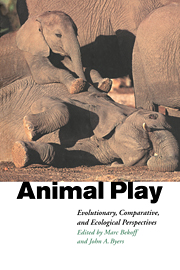Book contents
- Frontmatter
- Contents
- List of contributors
- Introduction
- 1 The evolutionary origins of play revisited: lessons from turtles
- 2 Play in common ravens (Corvus corax)
- 3 Object play by adult animals
- 4 Kangaroos at play: play behaviour in the Macropodoidea
- 5 Intentional communication and social play: how and why animals negotiate and agree to play
- 6 Structure-function interface in the analysis of play fighting
- 7 Sparring as play in young pronghorn males
- 8 Squirrel monkey play fighting: making the case for a cognitive training function for play
- 9 Self assessment in juvenile play
- 10 Biological effects of locomotor play: getting into shape, or something more specific?
- 11 Neurobiological sustrates of play behavior: glimpses into the structure and function of mammalian playfulness
- 12 Play as an organizing principle: clinical evidence and personal observations
- Index
6 - Structure-function interface in the analysis of play fighting
Published online by Cambridge University Press: 20 November 2009
- Frontmatter
- Contents
- List of contributors
- Introduction
- 1 The evolutionary origins of play revisited: lessons from turtles
- 2 Play in common ravens (Corvus corax)
- 3 Object play by adult animals
- 4 Kangaroos at play: play behaviour in the Macropodoidea
- 5 Intentional communication and social play: how and why animals negotiate and agree to play
- 6 Structure-function interface in the analysis of play fighting
- 7 Sparring as play in young pronghorn males
- 8 Squirrel monkey play fighting: making the case for a cognitive training function for play
- 9 Self assessment in juvenile play
- 10 Biological effects of locomotor play: getting into shape, or something more specific?
- 11 Neurobiological sustrates of play behavior: glimpses into the structure and function of mammalian playfulness
- 12 Play as an organizing principle: clinical evidence and personal observations
- Index
Summary
Introduction
In the ongoing commentary on Smith's (1982) target article on play, Moran (1985) wrote a critique entitled ‘Behavioral description and its impact on functional inference.’ In response, Smith (1985) wrote a counter-critique entitled ‘Functional hypotheses and their impact on behavioral description.’ While seemingly at odds, these two points of view are actually complementary. If play fighting did not resemble serious fighting, in at least some crude ways, then it is unlikely that the hypothesis that the former served as practice for the latter (Groos 1898) would ever have been considered. In this regard, description preceded functional inference. However, once formulated, such an hypothesis makes predictions about other features of the behavior, in this case, play fighting, which are not known. Therefore, behavioral description informs functional inference, which in turn, influences further description.
That play fighting functions as a means of refining the skills necessary for combat is an hypothesis which continues to receive widespread support (e.g., Caro 1988; Fagen 1981; Pellis 1981b; Smith 1982; Symons 1978a). Indeed, the hypothesis that play serves as practice is widely endorsed in lay treatments of the topic, as can be ascertained from both television nature documentaries and from popular books. For example, Angier (1995) asserts that ‘through play, animals can rehearse many of the moves they will need as adults’ (p. 133). With regard to play fighting, this hypothesis asserts that this form of play serves to practice the tactics of attack and defense, which would otherwise only occur in dangerous situations (Symons 1978a). The enhancement of fighting skills that such practice affords is often argued to be responsible for shaping the form of play fighting (Smith 1982).
- Type
- Chapter
- Information
- Animal PlayEvolutionary, Comparative and Ecological Perspectives, pp. 115 - 140Publisher: Cambridge University PressPrint publication year: 1998
- 42
- Cited by

